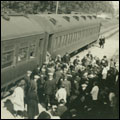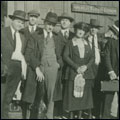By Susan Ditto, Department of History, University of Mississippi
 In 1852, two decades before the construction of the present Oxford Depot,
the Mississippi legislature chartered the Mississippi Central Railroad
to link Canton, Mississippi with Grand Junction, Tennessee. The road
would eventually connect Mississippi to a vast rail network that stretched
from the Gulf of Mexico to Bangor, Maine. Passenger trains from Holly
Springs began arriving in Oxford in late summer 1857. Service south
to Water Valley, began the following March. By early 1860 the Mississippi
Central Railroad linked Oxford by rail with the Gulf of Mexico in one
direction and the Ohio River in the other.
In 1852, two decades before the construction of the present Oxford Depot,
the Mississippi legislature chartered the Mississippi Central Railroad
to link Canton, Mississippi with Grand Junction, Tennessee. The road
would eventually connect Mississippi to a vast rail network that stretched
from the Gulf of Mexico to Bangor, Maine. Passenger trains from Holly
Springs began arriving in Oxford in late summer 1857. Service south
to Water Valley, began the following March. By early 1860 the Mississippi
Central Railroad linked Oxford by rail with the Gulf of Mexico in one
direction and the Ohio River in the other.
Oxford has seen three railroad depots since the 1850s. The original Mississippi Central depot was destroyed sometime during the Civil War, although the exact circumstances surrounding its fate remain a mystery. In 1866, the railroad built a small, temporary wood frame shelter, which served the town while it recovered from other war-time catastrophes. The present Italianate-style depot dates from 1872, the year that the Mississippi Central first entered into a lucrative partnership with Chicago’s Illinois Central Railroad.
Reflecting the general fascination with all things European that characterized American fashions during the Victorian era, the depot’s design sought to emulate the elegance and old world craftsmanship of Italian country villas. Aesthetic luxuries like the scrolled scissor brackets that support the depot’s deep overhanging eaves, its subtly arched windows, and arched brick reveals over the double loading bay doors were a testament to the optimism railroad officials felt for the future of their company and for the state of Mississippi in 1872.
 This
depot was a central part of daily life in town and on campus for seventy
years. As the University entered into an unprecedented era of expansion
in the 1870s, the depot’s waiting room and loading dock were alive
with students, faculty, and visitors. Mail trains delivered books, care
packages, and letters from family and friends. One-time university postmaster
William Faulkner, with help from his brother Murry, retrieved sacks
of mail bound for the University’s post office. On other occasions,
locals like Faulkner and his friend Phil Stone boarded trains headed
for the urban pleasures of Memphis. Sports fans rode in special cars
that followed baseball and football teams to contests far away. Local
children marveled at passing locomotives. Businessmen congregated at
the depot to get the latest news and to talk about crop prices or the
weather. During prohibition, men with a thirst for whiskey quietly purchased
bottles of liquor from passing trains. And always, people gathered at
the depot to bid farewell to honeymooners and soldiers or to welcome
loved ones home again. Those unable to afford a ticket could still sit
and dream as gleaming passenger cars manned by dapper Pullman Porters
approached then disappeared again, bound for exotic destinations like
Chicago or New Orleans.
This
depot was a central part of daily life in town and on campus for seventy
years. As the University entered into an unprecedented era of expansion
in the 1870s, the depot’s waiting room and loading dock were alive
with students, faculty, and visitors. Mail trains delivered books, care
packages, and letters from family and friends. One-time university postmaster
William Faulkner, with help from his brother Murry, retrieved sacks
of mail bound for the University’s post office. On other occasions,
locals like Faulkner and his friend Phil Stone boarded trains headed
for the urban pleasures of Memphis. Sports fans rode in special cars
that followed baseball and football teams to contests far away. Local
children marveled at passing locomotives. Businessmen congregated at
the depot to get the latest news and to talk about crop prices or the
weather. During prohibition, men with a thirst for whiskey quietly purchased
bottles of liquor from passing trains. And always, people gathered at
the depot to bid farewell to honeymooners and soldiers or to welcome
loved ones home again. Those unable to afford a ticket could still sit
and dream as gleaming passenger cars manned by dapper Pullman Porters
approached then disappeared again, bound for exotic destinations like
Chicago or New Orleans.
Throughout the 1890s, engineer Casey Jones regularly led trains through Oxford. The now legendary folk hero did not pass by here on his date with destiny in Vaughan, Mississippi in 1900. Instead, Oxonians were more familiar with Casey Jones the humble worker of the rails, whose signature whippoorwill whistle heralded his arrival and still lingers in the shadows of the Hilgard Cut.
 Within
a few decades, passenger service through Oxford, like Jones, would be
merely a memory. By 1906 the Illinois Central was clearly beginning
to favor its Grenada-to-Memphis route over the line through Oxford for
passenger service between New Orleans and Chicago as well as for freight
access to the Ohio River Valley. Cars, trucks, andbusses increasingly
competed with railroads beginning in the 1920s. Between 1927 and 1930,
railroad jobs and equipment moved from Water Valley to Paducah, Kentucky,
further reducing the significance of the old Mississippi Central line.
In 1931, the Illinois Central cut the number of daily stops in Oxford
from six to four. After the Great Depression, the company almost completely
abandoned branch lines like the one through Oxford, investing instead
in suburban commuter routes and long-distance express trains. The Illinois
Central discontinued passenger service through Oxford all together in
1941.
Within
a few decades, passenger service through Oxford, like Jones, would be
merely a memory. By 1906 the Illinois Central was clearly beginning
to favor its Grenada-to-Memphis route over the line through Oxford for
passenger service between New Orleans and Chicago as well as for freight
access to the Ohio River Valley. Cars, trucks, andbusses increasingly
competed with railroads beginning in the 1920s. Between 1927 and 1930,
railroad jobs and equipment moved from Water Valley to Paducah, Kentucky,
further reducing the significance of the old Mississippi Central line.
In 1931, the Illinois Central cut the number of daily stops in Oxford
from six to four. After the Great Depression, the company almost completely
abandoned branch lines like the one through Oxford, investing instead
in suburban commuter routes and long-distance express trains. The Illinois
Central discontinued passenger service through Oxford all together in
1941.
Freight continued to roll through, and occasionally stop in, Oxford for forty more years. In 1946, the Illinois Central relocated its regional headquarters from Water Valley, where it had been housed since before the Civil War, to Jackson, Tennessee, and in 1982, the southbound track out of Oxford was officially abandoned. The depot never saw regular freight service again.
The University purchased the depot in 1983. Although to many townsfolk the depot appeared forgotten, the University’s maintenance spared the depot from the ravages that befell so many of its kind. In 1992, the University successfully lobbied to have the depot declared a Mississippi Landmark, the highest honor that the State can bestow upon a property.
 After
many attempts by citizens, tourism experts, and developers to breathe
new life into the depot, the University secured a grant of $800,000
from the Mississippi Department of Transportation in the summer of 2001.
With an additional $200,000 in matching funds, the University and the
Mississippi Department of Archives and History worked together to restore
the depot and adapt it to modern use.
After
many attempts by citizens, tourism experts, and developers to breathe
new life into the depot, the University secured a grant of $800,000
from the Mississippi Department of Transportation in the summer of 2001.
With an additional $200,000 in matching funds, the University and the
Mississippi Department of Archives and History worked together to restore
the depot and adapt it to modern use.
The 130-year-old depot returned to community service in the fall of 2003 as a multipurpose facility with space for groups of up to sixty people for meetings, lectures, and other events. Today, the Oxford Depot is once again a place where students, locals, and visitors can gather. It stands ready to watch over Oxford and the University into the next century and beyond.

